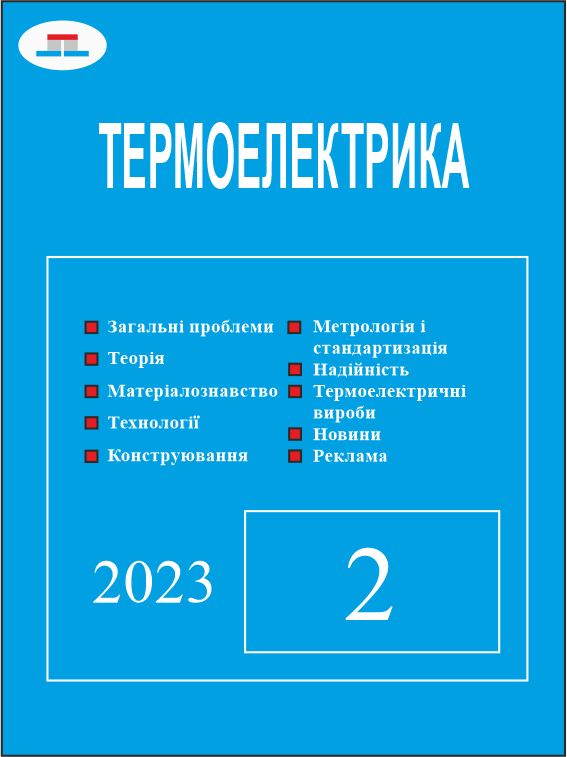Застосування машинного навчання для прогнозування властивостей термоелектричних матеріалів на основі Bi2Te3
Ключові слова:
методи машинного навчання, термоелектричне матеріалознавствоАнотація
У роботі наводяться приклади оцінки ефективності застосування машинного навчання для прогнозування властивостей термоелектричних матеріалів на основі Bi2Te3. Оглянуто результати їх застосування та способи вибору оптимальних параметрів вхідних даних, описано відмінності та особливості вибору алгоритмів, етапи роботи та навчання машинних моделей, а також критерії оцінки ефективності та валідації отриманих прогнозів.
The paper provides examples of assessing the effectiveness of machine learning for predicting the properties of Bi2Te3-based thermoelectric materials. The results of their application and methods for selecting optimal input data parameters are considered, the differences and features of choosing algorithms, the stages of work and training machine models, as well as the criteria for assessing the effectiveness and validation of the obtained forecasts are described.
Посилання
1. Wudil, Y. & Gondal, M.A. (2022). Predicting the thermoelectric energy figure of merit of Bi2Te3-based semiconducting materials: A machine learning approach. SSRN Electronic Journal. Elsevier BV. https://doi.org/10.2139/ssrn.4215166
2. Burkart, N. & Huber, M.F. (2021). A survey on the explainability of supervised machine learning. Journal of Artificial Intelligence Research, 70, 245 – 317. AI Access Foundation. https://doi.org/10.1613/jair.1.12228
3. Gaultois, M.W., Oliynyk, A.O., Mar, A., Sparks, T.D., Mulholland, G.J. & Meredig, B. (2016). Perspective: Web-based machine learning models for real-time screening of thermoelectric materials properties. APL Materials, 4 (5). AIP Publishing. https://doi.org/10.1063/1.4952607
4. Gonzalez Zelaya, C.V. (2019). Towards explaining the effects of data preprocessing on machine learning. IEEE 35th International Conference on Data Engineering (ICDE). IEEE. https://doi.org/10.1109/icde.2019.00245
5. Parv Katyal, Madhav Rathi, Piyush Mehra and Amrish K. Panwar (2020). Evaluation of figure of merit of thermoelectric materials using machine learning. International Journal of Advanced Science and Technology, 29 (11s), 2858 – 2863. Retrieved from http://sersc.org/journals/index.php /IJAST/article/view/23766
6. Liu, Y., Wang, Y., & Zhang, J. (2012). New machine learning algorithm: random forest. In Information Computing and Applications (pp. 246 – 252). Springer Berlin Heidelberg. https://doi.org/10.1007/978-3-642-34062-8_32
7. Wang, Z., Yokoyama, Y., Onda, T., Adachi, Y., & Chen, Z. (2019). Improved thermoelectric properties of hot‐extruded Bi-Te-Se bulk materials with Cu doping and property predictions via machine learning. Advanced Electronic Materials, 5 (6). Wiley. https://doi.org/10.1002/ aelm.201900079
8. A. Ramezan, C., A. Warner, T., & E. Maxwell, A. (2019). Evaluation of sampling and cross-validation tuning strategies for regional-scale machine learning classification. Remote Sensing, 11 (2), 185. MDPI AG. https://doi.org/10.3390/rs11020185
9. Alloghani, M., Al-Jumeily, D., Mustafina, J., Hussain, A., & Aljaaf, A. J. (2019). A systematic review on supervised and unsupervised machine learning algorithms for data science. Unsupervised and Semi-Supervised Learning (pp. 3 – 21). Springer International Publishing. https://doi.org/10.1007/978-3-030-22475-2_1
10. Na, G. S. (2023). Artificial intelligence for learning material synthesis processes of thermoelectric materials. Chemistry of Materials, 35(19), 8272 – 8280). American Chemical Society (ACS). https://doi.org/10.1021/acs.chemmater.3c01834
11. Sheng, Y., Deng, T., Qiu, P., Shi, X., Xi, J., Han, Y., & Yang, J. (2021). Accelerating the discovery of Cu-Sn-S thermoelectric compounds via high-throughput synthesis, characterization, and machine learning-assisted image analysis. Chemistry of Materials, 33 (17), 6918 – 6924. American Chemical Society (ACS). https://doi.org/10.1021/acs.chemmater.1c01856
12. Jia, X., Deng, Y., Bao, X., Yao, H., Li, S., Li, Z., Chen, C., Wang, X., Mao, J., Cao, F., Sui, J., Wu, J., Wang, C., Zhang, Q., & Liu, X. (2022). Unsupervised machine learning for discovery of promising half-Heusler thermoelectric materials. Computational Materials, 8 (1). Springer Science and Business Media LLC. https://doi.org/10.1038/s41524-022-00723-9
13. CAO, Y., MIAO, Q.-G., LIU, J.-C., & GAO, L. (2013). Advance and prospects of AdaBoost algorithm. Acta Automatica Sinica, 39 (6), 745 – 758. Elsevier BV. https://doi.org/10.1016/s1874-1029(13)60052-x
14. Wudil Y.S. (2023). Ensemble learning-based investigation of thermal conductivity of Bi2Te2.7Se0.3-based thermoelectric clean energy materials. Results in Engineering, 18, 101203. Elsevier BV. https://doi.org/10.1016/j.rineng.2023.101203
15. Wang T., Zhang C., Snoussi H., & Zhang G. (2019). Machine learning approaches for thermoelectric materials research. Advanced Functional Materials, 30 (5). Wiley. https://doi.org/10.1002/adfm.201906041
16. Qu, R., Lv, Y., & Lu, Z. (2023). A deep neural network potential to study the thermal conductivity of MnBi2Te4 and Bi2Te3/MnBi2Te4 superlattice, Journal of Electronic Materials, 52 (7), 4475 – 4483). Springer Science and Business Media LLC. https://doi.org/10.1007/s11664-023-10403-z
17. Agarwal, A., Banerjee, T., Gockel, J., LeBlanc, S., Walker, J., & Middendorf, J. (2023). Predicting thermoelectric power factor of bismuth telluride during laser powder bed fusion additive manufacturing (Version 1). arXiv. https://doi.org/10.48550/ARXIV.2303.15663
18. Headley, C. V., Herrera del Valle, R. J., Ma, J., Balachandran, P., Ponnambalam, V., LeBlanc, S., Kirsch, D., & Martin, J. B. (2024). The development of an augmented machine learning approach for the additive manufacturing of thermoelectric materials. Journal of Manufacturing Processes, 116, 165 – 175). Elsevier BV. https://doi.org/10.1016/j.jmapro.2024.02.045


